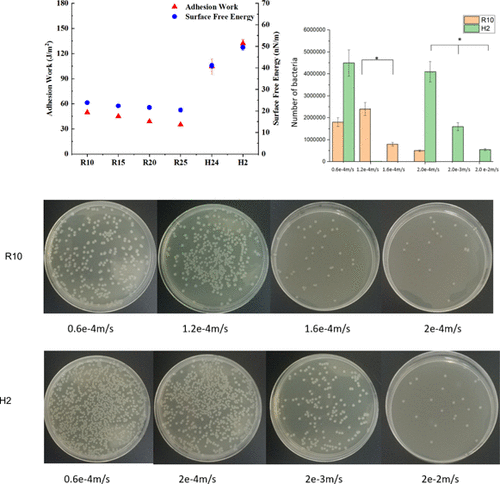当前位置:
X-MOL 学术
›
ACS Appl. Bio Mater.
›
论文详情
Our official English website, www.x-mol.net, welcomes your
feedback! (Note: you will need to create a separate account there.)
Effects of Hydrophilicity, Adhesion Work, and Fluid Flow on Biofilm Formation of PDMS in Microfluidic Systems
ACS Applied Bio Materials ( IF 4.6 ) Pub Date : 2020-11-17 , DOI: 10.1021/acsabm.0c00660 Jinling Zhu 1 , Minqi Wang 2 , Hongbo Zhang 1 , Shengbing Yang 2 , Ki-Young Song 3 , Ruixue Yin 1 , Wenjun Zhang 4, 5
ACS Applied Bio Materials ( IF 4.6 ) Pub Date : 2020-11-17 , DOI: 10.1021/acsabm.0c00660 Jinling Zhu 1 , Minqi Wang 2 , Hongbo Zhang 1 , Shengbing Yang 2 , Ki-Young Song 3 , Ruixue Yin 1 , Wenjun Zhang 4, 5
Affiliation

|
Polydimethylsiloxane (PDMS) has been the most widely used material in microfluidic systems, especially for cell biology applications. However, the antibacterial performance of PDMS in flow conditions has never been reported in the literature. In this paper, we analyzed the effects of contact angle (CA), adhesion force (work), and surface free energy on the antibacterial activities of PDMS by varying the ratio of curing agents (crosslinking degree) and surface modification with oxygen plasma. The results show that the Young’s modulus has no particular effects on bacterial adhesion compared to the CAs of samples. For the first time, we analyzed the adhesion work (AW) effect on biofilm formation, and we found that biofilms tend to form on the surface with less AW. Furthermore, we analyzed the dual effect of hydrophilicity and shear force induced by fluid flow on the bacterial adhesion in PDMS microfluidic systems. We found that at low flow rates in microfluidic conditions, the adhesion of the bacteria on the PDMS surface is inhibited when the fluid flow exceeds a certain value. It required higher shear force to inhibit bacterial adhesion on the hydrophilic surface than on the hydrophobic surface. Therefore, hydrophilicity might be the dominant factor affecting bacterial adhesion.
中文翻译:

亲水性、粘附功和流体流动对微流体系统中 PDMS 生物膜形成的影响
聚二甲基硅氧烷 (PDMS) 一直是微流体系统中使用最广泛的材料,尤其是在细胞生物学应用中。然而,文献中从未报道过PDMS在流动条件下的抗菌性能。在本文中,我们通过改变固化剂的比例(交联度)和氧等离子体表面改性,分析了接触角(CA)、粘附力(功)和表面自由能对 PDMS 抗菌活性的影响。结果表明,与样品的 CA 相比,杨氏模量对细菌粘附没有特别的影响。我们首次分析了粘附功(AW)对生物膜形成的影响,我们发现生物膜倾向于在表面形成,而 AW 较少。此外,我们分析了流体流动引起的亲水性和剪切力对 PDMS 微流体系统中细菌粘附的双重影响。我们发现,在微流体条件下的低流速下,当流体流量超过一定值时,细菌在 PDMS 表面的粘附受到抑制。与疏水表面相比,它需要更高的剪切力来抑制细菌在亲水表面的粘附。因此,亲水性可能是影响细菌粘附的主要因素。与疏水表面相比,它需要更高的剪切力来抑制细菌在亲水表面的粘附。因此,亲水性可能是影响细菌粘附的主要因素。与疏水表面相比,它需要更高的剪切力来抑制细菌在亲水表面的粘附。因此,亲水性可能是影响细菌粘附的主要因素。
更新日期:2020-12-21
中文翻译:

亲水性、粘附功和流体流动对微流体系统中 PDMS 生物膜形成的影响
聚二甲基硅氧烷 (PDMS) 一直是微流体系统中使用最广泛的材料,尤其是在细胞生物学应用中。然而,文献中从未报道过PDMS在流动条件下的抗菌性能。在本文中,我们通过改变固化剂的比例(交联度)和氧等离子体表面改性,分析了接触角(CA)、粘附力(功)和表面自由能对 PDMS 抗菌活性的影响。结果表明,与样品的 CA 相比,杨氏模量对细菌粘附没有特别的影响。我们首次分析了粘附功(AW)对生物膜形成的影响,我们发现生物膜倾向于在表面形成,而 AW 较少。此外,我们分析了流体流动引起的亲水性和剪切力对 PDMS 微流体系统中细菌粘附的双重影响。我们发现,在微流体条件下的低流速下,当流体流量超过一定值时,细菌在 PDMS 表面的粘附受到抑制。与疏水表面相比,它需要更高的剪切力来抑制细菌在亲水表面的粘附。因此,亲水性可能是影响细菌粘附的主要因素。与疏水表面相比,它需要更高的剪切力来抑制细菌在亲水表面的粘附。因此,亲水性可能是影响细菌粘附的主要因素。与疏水表面相比,它需要更高的剪切力来抑制细菌在亲水表面的粘附。因此,亲水性可能是影响细菌粘附的主要因素。











































 京公网安备 11010802027423号
京公网安备 11010802027423号